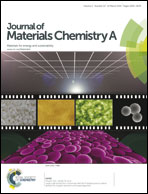Submerged liquid plasma – low energy synthesis of nitrogen-doped graphene for electrochemical applications†
Abstract
In this study, micro-plasma discharge is produced by applying a high electric potential between graphite and Pt electrodes in acetonitrile solvent. The electrons generated in the micro-plasma discharge collide with acetonitrile and produce ˙H and ˙CH2CN radicals. The radicalized graphene layer exfoliated from the graphite electrode reacts with nascent hydrogen (˙H) and acetonitrile (˙CH2CN) radicals and partially restores its aromaticity and conjugation. Raman spectra of the product confirm the synthesis of nitrogen-functionalized graphene (N-FG), which has a marginal increase in disorderness compared to that of pure graphite and remarkable dispersibility in both hydrophilic and hydrophobic solvents. The excellent fluorescence properties of N-FG confirm the presence of fluorophores such as –NH and –N![[double bond, length as m-dash]](https://www.rsc.org/images/entities/char_e001.gif) C– at the radicalized graphene sites, as supported by ultraviolet-visible spectroscopy and X-ray photoelectron spectroscopy studies. The functional groups present in N-FG lead to excellent electrochemical performance, with distinct redox peaks in cyclic voltammetry and a high specific capacitance of 291 F g−1 at a scan rate of 5 mV s−1. N-FG exhibits excellent cycling stability, with a marginal reduction of specific capacitance (<10% reduction) at the end of 1000 cycles.
C– at the radicalized graphene sites, as supported by ultraviolet-visible spectroscopy and X-ray photoelectron spectroscopy studies. The functional groups present in N-FG lead to excellent electrochemical performance, with distinct redox peaks in cyclic voltammetry and a high specific capacitance of 291 F g−1 at a scan rate of 5 mV s−1. N-FG exhibits excellent cycling stability, with a marginal reduction of specific capacitance (<10% reduction) at the end of 1000 cycles.

- This article is part of the themed collection: 2014 Journal of Materials Chemistry A Hot Articles

 Please wait while we load your content...
Please wait while we load your content...